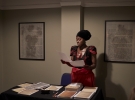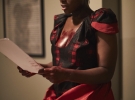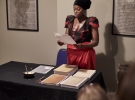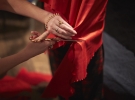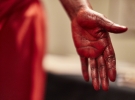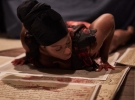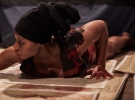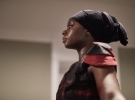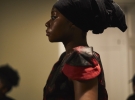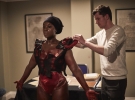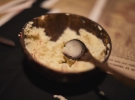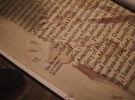
Into the Mind of the Coloniser. 28 March 2019
Adelaide Damoah has spent years searching for books, stamps, photos and maps relating to the British Empire. In 2018 she found an archive of out of print books relating to the Empire printed between the mid 17th and mid 19th century. There were 204 in total. Of the books she discovered, Damoah states, “ What I have read so far, with my 21st Century eyes has been a revelation. Not an altogether surprising revelation. However, it has helped me to place our present situation (race, migration, immigration) in context relative to our history.” The discovery of these books has prompted Damoah to deepen her lifelong mission of investigating the history of colonisation and to utilise the texts in her studio and performance practice. She has named the overall project, “Confronting Colonisation.”
“Just think for a moment what it is to have been born an Englishman; think how many millions of men there are in this world to-day who have been born Chinese, or Hindus or Kaffirs; but you were not born any of these, you were born an Englishman.” Ellis T Powell quoting Cecil Rhodes in “The Sheaves of Empire. A light on the Higher Aspects of Imperialsim 1910- one of the books in the found archive. * (Kaffir is the derogatory term used for black people during that time- mostly in South Africa) . Here we see Cecil Rhodes, the father of Apartheid, expressly placing himself and Englishmen above all men.
Of the above passage, Damoah states, “This kind of language and belief system is at the heart of everything I have read so far from this time period. From the mouths of the colonisers themselves- who were mostly the elite. The colonial project simply could not have worked, could not have been justified, had they not ensured that all other races were dehumanised and made subject races. Lesser than.”
On the 28 March 2019 Adelaide Damoah performed the first iteration of the project (Into the Mind of the Coloniser) with Open Space Contemporary at an event called, Forum “Of Hosts and Guests. It took place at Mary Ward House, Bloomsbury, London and was curated by Katherine Finerty . Damoah is the channel by which the previously unknown became known again. Bringing history to life. A rebirth via the ritual of the Ghanaian funeral. Bringing the unknown back into the known to become known again as the shadow figure. The imaginative process of the uncanny.
Before each performance, Damoah consciously channels the image and spirit of her great grandmother, Ama. Through this conduit, Ama comes to life. It is of great importance for this performance as Damoah considers it a way of paying her respects to the past. Dressed in Ghanaian funeral attire, reminiscent of the colonial era in its appearance, (whilst simultaneously being traditional and hence precolonial); Damoah read aloud from the selected texts, her hands, coated in what looked like dried blood (paint and food dye.) She then proceeded to envelop her hands in shea butter from Ghana, in order to activate the paint which she then placed on the pieces of manuscript and continued to read. Further into the performance, Damoah invited the audience to cut away her clothes (referencing Yoko Ono’s 1965 Cut Piece) and they continued to cut until pieces of the cloth were piled on the floor and her apparently blood stained skin and underwear were exposed. She reactivated the dried paint with shea butter and proceeded to print her body onto large sheets of printed texts which were strewn on the floor, leaving a shadow of the past, on the present. As the site of colonial violence, the body has the power to recall past traumas and heal old wounds; to represent one’s ancestry and anticipate one’s legacy.
After the performance, Damoah said, “I felt controlled anger and a sense of power in the delivery of some particularly harsh and cold words and there was a distinct energy of shock and concentration and sadness in the air. It was electric and simultaneously positive as it was a visceral learning experience for many in attendance and for myself. All of my performances have at their core the principle of Sankofa- ancient Akan (Ghanaian) idea which tells us to learn from our past in order to live a better present and future. No performance I have ever done has embodied this concept more deeply than this one. Everything I have learned so far from studying these texts has helped me to put our present into context and to understand more fully some of our current situation regarding migration/immigration etc. Humans have suffered throughout history. We are still suffering and causing the suffering of others through action or inaction.”.
The concept of Sankofa is at the core of all of Damoah’s practice, but especially this body of work- because it so directly references our history. Everything the artist does is an attempt to gain an understanding of our present circumstances. Ultimately, Damoah wants the discourse stimulated by the the work to encourage understanding, growth and empathy.
Interest in Decolonisation and Introduction to Concept
I have an interest in the theme of decolonisation as a reasonably politically-engaged citizen who is also the daughter of people who were alive when present-day Ghana was a British ‘possession’. We live in a society which is still shaped by imperial power structures. I am referring to society as a whole when talking about decolonising culture. Is culture not the distillation of the customs, ideas, knowledge, and social norms of a people? The art world is a part of that. When we talk about decolonising in the context of the art world, we are often referring to the inclusion of stories about the “other,” and about issues of representation – the importance of seeing oneself and others represented in popular culture.
But I am also talking about decolonising the human mind (the title of Wa Thiong’o’s book which was the catalyst for much thought and published work on the decolonisation of the African mind). Gaining knowledge of oneself (whatever your identity is) and understanding of our colonial past so that we can understand our present. The “de” in decolonising is about achieving knowledge and understanding so that past mistakes are not repeated, while at the same time including multiple perspectives that are relevant to where we are today. It is about placing multiple perspectives in a dialogue with each other while simultaneously gaining knowledge and understanding the past and its impact on our present and potential futures.
As the daughter of Ghanaian parents, I have always had a particular interest in colonial history and knew that eventually I would explore the relationship between Ghana and Britain in my work. In 2016, I went to Ghana looking for old photographs from the colonial era of my family. I found a very powerful image of my maternal great grandmother (Ama) which was taken in 1920 when Ghana was called the British Gold Coast. I knew that I had to use this image in my artwork as the beginning of a new life.
I started by using various image transfer techniques onto body prints and combining both images and prints with text – with no certainty as to where the use of the image would lead – in works such as Great Angel Mother (2016) Great Angel Golden Mother (2016), You Should Learn to Speak the Language (2017), My Dad thinks I am Honest (2017) and most recently The Rebirth of Ama (2018).
The artwork for my ‘Genesis’ exhibition marked the beginning of deeper research into the general history of the British Empire. In the process, I came across a large archive of out of print books dated from 1649 to around 1920 on the subject. Among these texts are historical accounts written from the perspective of self-described colonisers and colonial administrators. I immediately knew that I wanted to incorporate these works into my performance practice to highlight the mentality of those actively engaged in colonial rule. This work is a further development of my ‘Bible Page’ series (which I produced for ‘Genesis’) where I used black pigment and 24 carat gold leaf to produce hand and face prints on the pages of a bible dating from the 1800’s as part of my exploration of the religious/colonial history between Ghana, my family and the UK.
In January 2019, I was approached by Open Space Contemporary with a brief for an exciting project which touched on colonialism and the concept of being a host a host or a guest. Into the Mind of the Coloniser was born out of brainstorming for this project.
Into the Mind of the Coloniser (March 2019)
Open Space Forum: Of Hosts and Guests. Curated by Katherine Finerty
During this performance I functioned as the channel by which the mind of the coloniser begins as unknown, becomes uncannily known, and finally unknown again, thereby temporarily re-birthing the recorded history of the coloniser as a shadow figure using the ritual of the Ghanaian funeral.
I also consciously channel the image and spirit of my great grandmother Ama in all of my performances. This was especially important for this performance as I was paying my respects to the past. Dressed in Ghanaian funeral attire which is reminiscent of the colonial era in its appearance, (whilst simultaneously being traditional and hence precolonial) I read aloud from the selected texts. My hands were coated in what looked like dried blood (paint and food dye) and in between reading, I coated my hands in shea butter from Ghana to activate the paint and printed my hands onto the papers I had read aloud.
At later points in the performance, I invited the audience to cut off my clothes (referencing Yoko Ono’s 1965 Cut Piece) and they continued to cut until pieces of the cloth were piled on the floor and my apparently blood stained skin and underwear was exposed. I reactivated the dried paint with shea butter and proceeded to print my body onto large sheets of printed texts which were spread on the floor, leaving a shadow of the past on the present.
As the site of colonial violence, the body has the power to recall past traumas and heal old wounds, to represent one’s ancestry and anticipate one’s legacy.
[T]he African… establishes a continuum between the worlds of the living, of the ancestor and the unborn… The animist [life of] grace is… rooted in the rituals and observances of African societies… [it] lies at the heart of artistic intuitions and… [is a] pantheistic resolution of all spiritual urgings… [this] animism… [includes attempts] to penetrate beneath [physical material] reality to extract an [metaphysical spiritual] other- reality that is interwoven with the physical and opens itself to a pantheistic universalism. (Wole Soyinka)
“There is nothing more fearful and uncanny in…man than his mnemotechnics. ‘If something is to stay in the memory it must be burned in: only that which never ceases to hurt stays in the memory’ … Man could never do without blood, torture and sacrifices when he felt the need to create a memory for himself; the most dreadful sacrifices… the most repulsive mutilations… the cruelest rites of all the religious cults… has its origin in the instinct which realised that pain is the most powerful aid to mnemonics. ( Frederich Nietzche )
Performance images by Ben Peter Catchpole And courtesy of Open Space Contemporary. Special thanks to Huma Kabakci, founder of Open Space, Halime Ozdemir- Public Relations manager at Open Space and Katherine Finerty Forum guest curator.
Promo images by Jennifer Moyes.




